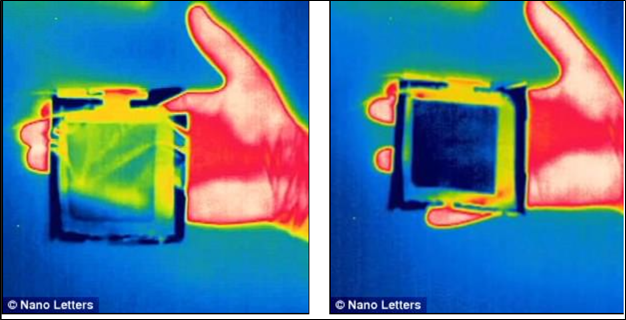an email newsletter released every month highlighting the latest articles, events, technical inquires, and voices from the community
Use of Graphene for Stealth in Unmanned Aircraft Systems (UAS)

Posted on October 14, 2020 | Completed on August 10, 2020 | By: Taylor H. Knight
What is an analysis for using graphene to achieve stealth in small unmanned aircraft systems (UASs)?
The Defense Systems Information Analysis Center (DSIAC) was asked to conduct an analysis of the use of graphene for stealth in unmanned aerial vehicles (UAVs). DSIAC staff searched a variety of databases, including open-source documents, the Defense Systems Information Analysis Center’s repository, and Scopus, to identify relevant publications. Few sources found mentioned the successful use of graphene in UAVs, specifically for stealth. Graphene shows many promising benefits for aerospace applications, including reducing drag and increasing impact resistance, thermal management, lightning resistance, and stealth in UAVs. Using graphene as a skin on UAVs is currently being researched, with the goal of widespread use in aerospace. Relevant research has been included that could have potential stealth applications in aerospace.
1.0 Introduction
While graphene was discovered over a decade ago, its uses continue to prove innumerable for aerospace applications. Graphene has been shown to absorb light radiation, making it ideal for UAVs in stealth applications and missions. Ongoing research is working toward applying graphene in aerospace applications, including graphene skins for stealth. With this being a relatively new technology, publications were limited.
The Defense Systems Information Analysis Center searched open-source documents for research mentioning graphene use for stealth in UAVs. Since being discovered in its stable state in 2010 by isolating it from graphite, graphene has been shown to have multiple applications in the aerospace sector. Stable graphene is incredibly strong, cheap, and has extraordinary mechanical, thermal, and electrical properties. Graphene is 200× stronger than steel but 6× less dense, which allows UAVs to be more lightweight, incredibly stronger, and more fuel efficient. It shows a resistance to lightning strikes by being built into the carbon fiber of aircrafts, creating a skin. Graphene skin distributes heat evenly across an aircraft, which can prevent ice buildup. It can be used in boosting battery power, if incorporated [1].
2.0 Graphene Research
Due to its multiple applications in aerospace, many researchers are exploring how graphene can be used for stealth applications.
Ultralight graphene foam (GF) and multiwalled carbon nanotubes/multiwalled graphene foam (MGF) have been demonstrated to achieve both superior terahertz shielding and stealth performance due to the dominant absorption loss, with negligible reflection. Terahertz shielding effectiveness values of GF and MGF, both 3 mm thick, reach up to 74 and 61 dB. Their average terahertz reflection loss values are achieved up to 23 and 20 dB, respectively, which are the best results in existing broadband terahertz shielding/stealth materials. Comprehensively considering the important indicators of density, bandwidth, and intensity, the specific average terahertz shielding coefficient and the specific average terahertz absorption performance are achieved up to 1.1 × 105 and 3.6 × 104 dB cm3 g−1, respectively, which is over thousands of times larger than other kinds of materials reported previously [1].
Graphene is also being researched for use in thermal camouflage, or a real-life invisibility cloak. In a study led by the University of Manchester’s graphene expert, Professor Coskun Kacabas, a thin and flexible material using graphene is being investigated [2]. The graphene material contains a super-strength layer of carbon atoms that conducts electricity. When a current is applied to the graphene, it stops producing the tell-tale infrared radiation that would otherwise give away the wearer’s position. The material is thin, light, and easy to bend around objects, meaning it could cover military personnel or weapons. It adapts to shield hot or cold objects from thermal-imaging cameras, leading to new technologies for thermal camouflage and stealth missions [2]. This material is currently being marketed for adaptive bodywear for soldiers, such as the glove seen in Figure 1, but has the potential use for other military uses. In the figure, the glove is made using the “miracle material” graphene and can quickly adapt to shield hot or cold objects from thermal-imaging cameras.

Figure 1: Thermal Imagery of the Material Before (Left) and After (Right) Activation. Red, Green, and Yellow Show Hot While Blue Shows Cold [8] (image used with permission).
In 2014, researchers explored how graphene can be used for electromagnetic interference (EMI) shielding. A high‐performance, EMI shielding composite based on reduced graphene oxide (rGO) and polystyrene (PS) was realized via high‐pressure, solid‐phase compression molding. Superior shielding effectiveness of 45.1 dB, the highest value among rGO-based polymer composite, was achieved with only 3.47 vol% rGO loading. This allowed a multifaceted, segregated architecture, with rGO selectively located on the boundaries among PS multifacets. The special architecture not only provided many interfaces to absorb the electromagnetic waves but also dramatically reduced the loading of rGO by confining it at the interfaces. Moreover, the mechanical strength of the segregated composite was dramatically enhanced using high pressure at 350 MPa, overcoming the major disadvantage of the composite made by conventional pressure (5 MPa). The composite prepared by the higher pressure showed 94% and 40% increments in compressive strength and compressive modulus, respectively. These results demonstrated a promising method to fabricate an economical, robust, and highly efficient EMI shielding material [3].
Other research has shown that graphene absorbs 2% of light radiation while blocking any gases completely, so it is perfect for bullet and bomb proofing shields and windows of vehicles and highly secure buildings [4]. University of Michigan researchers found that graphene carbon nanotubes also absorb radar, with suspension in paint likely to add to stealth capabilities to existing craft [5].
3.0 Graphene in Drones
In 2016 at the Farnborough International Air Show in the United Kingdom, the world saw the maiden flight of the first model aircraft with graphene incorporated in its structure. Researchers found graphene reduced drag, increased impact resistance, and showed promising thermal management [6].
In 2018, the University of Central Lancashire (UCLan) unveiled Juno, the world’s first graphene skinned UAV. The UCLan engineering team worked with the Sheffield Advanced Manufacturing Research Center, the University of Manchester’s National Graphene Institute, Haydale Graphene Industries, and other businesses to develop Juno, which also included graphene batteries and three-dimensional printed parts [7]. The team plans to continue investigating the potential effects of graphene in drag reduction, thermal management, and, ultimately, the ability to achieve lightning strike protection for aerospace and other related opportunities.
References
[1] Huang, Z., H. Chen, S. Xu, L. Y. Chen, Y. Huang, Z. Ge, W. Ma, J. Liang, F. Fan, S. Chang, and Y. Chen. “Graphene-Based Composites Combining Both Excellent Terahertz Shielding and Stealth Performance.” Advanced Optical Materials, vol. 6, issue 23, https://onlinelibrary.wiley.com/doi/abs/10.1002/adom.201801165, 21 October 2018.
[2] Pettit, H., and C. Fernandez. “A Step Towards an Invisibility Cloak: Graphene Sheet With ‘Thermal Camouflage’ Can Hide Soldiers From Infrared Cameras.” https://www.dailymail.co.uk/ sciencetech/article-5891815/Invisibility-cloak-graphene-glove-thermal-camouflage-disguises-hot-cold.html, 27 June 2018.
[3] Yan, D.-X., H. Pang, B. Li, R. Vajtai, L. Xu, P.-G. Ren, J.-H. Wang, and Z.-M. Li. “Structured Reduced Graphene Oxide/Polymer Composites for Ultra‐Efficient Electromagnetic Interference Shielding.” Advanced Functional Materials, vol. 25, issue 4, https://onlinelibrary.wiley.com/doi/ abs/10.1002/adfm.201403809, 2 December 2014.
[4] Usama, M. “A Graphene Skinned UAV.” https://dronebelow.com/2018/08/16/a-graphene-skinned-uav/, 16 August 2018.
[5] Cawley, C. “How Graphene Might Revolutionize Industry Beyond Semiconductors.” https://www.electropages.com/blog/2019/02/graphene-revolutionise-industry-semiconductors, 18 February 2019.
[6] Moore, S. “How Drones Can Benefit From Graphene.” https://www.azorobotics.com/Article. aspx?ArticleID=320, 24 September 2019.
[7] Ball, M. “World’s First Graphene-Skinned UAS Unveiled.” https://www.unmannedsystems technology.com/2018/08/worlds-first-graphene-skinned-uas-unveiled/, 7 August 2018.
[8] Salihoglu, O., H. B. Uzlu, O. Yakar, S. Aas, O. Balci, N. Kakenov, S. Balci, S. Olcum, S. Suzer, and C. Kocabas. “Graphene-Based Adaptive Thermal Camouflage.” American Chemical Society Publications, vol. 18, no. 7, pp 4541 – 4548, https://pubs.acs.org/doi/abs/10.1021/acs.nanolett.8b01746, 27 June 2018.
Want to find out more about this topic?
Request a FREE Technical Inquiry!

